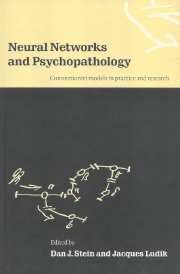Book contents
- Frontmatter
- Contents
- List of contributors
- Preface
- Part one General Concepts
- Part two Clinical disorders
- 7 The nature of delusions: a hierarchical neural network approach
- 8 ‘Produced by either God or Satan’: neural network approaches to delusional thinking
- 9 Neural network modelling of cognitive disinhibition and neurotransmitter dysfunction in obsessive–compulsive disorder
- 10 The fables of Lucy R.: association and dissociation in neural networks
- 11 Neural network analysis of learning in autism
- 12 Are there common neural mechanisms for learning, epilepsy, and Alzheimer's disease?
- Epilogue
- Index
8 - ‘Produced by either God or Satan’: neural network approaches to delusional thinking
from Part two - Clinical disorders
Published online by Cambridge University Press: 12 January 2010
- Frontmatter
- Contents
- List of contributors
- Preface
- Part one General Concepts
- Part two Clinical disorders
- 7 The nature of delusions: a hierarchical neural network approach
- 8 ‘Produced by either God or Satan’: neural network approaches to delusional thinking
- 9 Neural network modelling of cognitive disinhibition and neurotransmitter dysfunction in obsessive–compulsive disorder
- 10 The fables of Lucy R.: association and dissociation in neural networks
- 11 Neural network analysis of learning in autism
- 12 Are there common neural mechanisms for learning, epilepsy, and Alzheimer's disease?
- Epilogue
- Index
Summary
A schizophrenic man is convinced that the CIA performed cardiac surgery on him on the army and gave him a lizard's heart; now his blood pumps through only three chambers, which means any medication he takes is going to be very dangerous for him.
A lonely erotomanic woman tells an elaborate story of how California politician, Jerry Brown, secretly fell in love with her when she wrote him a fan letter 20 years ago; Brown still signals his passion to her whenever he is photographed in profile.
Most of us would agree that these are examples of delusional thinking, one of ‘the main psychiatric phenomena’ encountered by clinicians in everyday practice (Brockington, 1991). In keeping with Jaspers' classic description of half a century ago (1946), these examples show the hallmark characteristics of subjective certainty, incorrigibility, and impossible (or improbable) content. Until now, clinical psychiatry has been preoccupied with only one of these features, namely the content – and thus we focus on whether a patient's delusion is bizarre, on whether it is well systematized, on whether it is paranoid or somatic or grandiose. Yet any experienced clinician also knows two other perplexing things about delusions. The first is that ‘however sharply they may be defined logically, they are not sharply demarcated from normal thinking’ (Brockington, 1991, p. 42). The second is that delusional thinking is more than the sum of its contents.
- Type
- Chapter
- Information
- Neural Networks and PsychopathologyConnectionist Models in Practice and Research, pp. 189 - 230Publisher: Cambridge University PressPrint publication year: 1998
- 2
- Cited by



